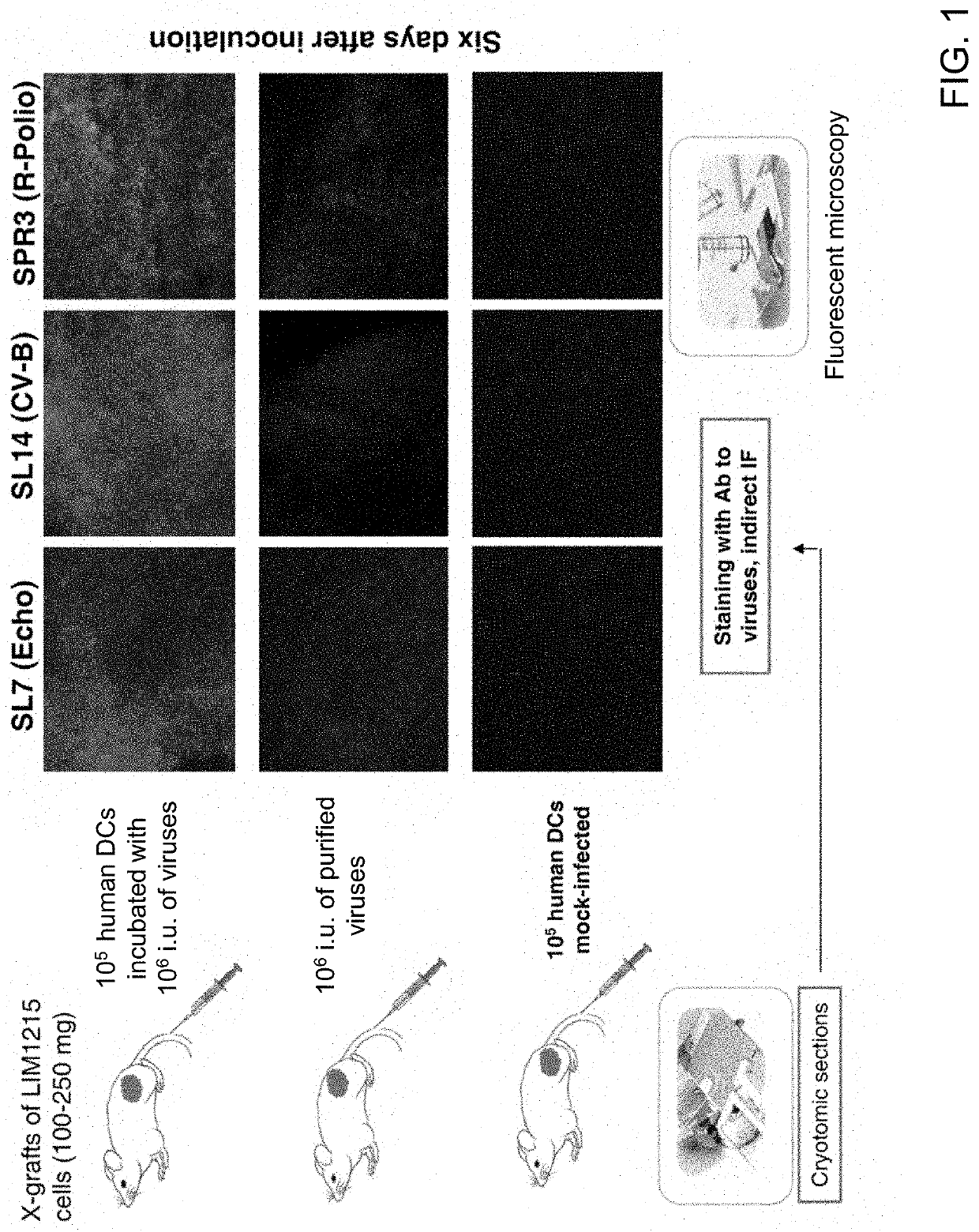Delivery of oncolytic viruses using dendritic cells
- Summary
- Abstract
- Description
- Claims
- Application Information
AI Technical Summary
Benefits of technology
Problems solved by technology
Method used
Image
Examples
example 1
Obtaining Dendritic Cells from Human Peripheral Blood
[0075]Solutions and Media:[0076]RPMI-1640 cell culture media, supplemented with 10% fetal bovine serum.[0077]RPMI-1640 cell culture media, supplemented with 2 mM L-glutamine, 25 mM HEPES, 10% fetal bovine serum;[0078]PBS-complete;[0079]PBS buffer with 10 mM HEPES, 0.5% BSA and 1% glucose, pH 7.4.
[0080]Monocyte Isolation:
[0081]Pour into a 50 mL test tube 15 mL Ficoll® (density=1.077). Ficoll is the trademark for a neutral, highly branched, high-mass, hydrophilic polysaccharide which dissolves readily in aqueous solutions. Ficoll radii range from 2-7 nm. It is prepared by reaction of the polysaccharide with epichlorohydrin.
[0082]Collect blood into a vacutainer (we used 2 9 ml vacutainers with K3EDTA, lot #A15104KD). Total amount of blood required for the isolation is 30 mL. Do not chill the blood, use as fresh as possible (3-4 hours is OK). Bring the blood with PBS-complete to 200 m L.
[0083]Place 15 mL of Ficoll® solution (density=1...
example 2
Ex Vivo Loading, Cellular Model
[0099]Human dendritic cells efficiently transfer oncolytic viruses to virus-sensitive cells. 2×105 dendritic cells were incubated with 2×106 infectious units (i.u.) of viruses for 2 hours at 37° C. The dendritic cells were then washed 3× with phosphate buffered saline (PBS) and incubated with neutralizing antibodies to the viruses for 1 hour. Serial dilutions of infected dendritic cells were then added to virus-sensitive cells and the efficiency of virus transfer was measured by counting the number of infected viral particles per the sensitive cell (reflected as MOI (multiplicity of infection) units). The percentage of infected cells varied with different virus strains, but on average was ˜50% for many viruses used. See Table A below.
TABLE A% infected dendritic cellsVirus strain(MOI = 10 i.u. / cell)SL7 (Echovirus)25-50SL14 (Coxsackie B-like)15-20SPR3 (recombinant Poliovirus III)25-50SL7 (Coxsackievirus A-like)30-75SL4 (Echovirus)15-30SR2 (Orthoreovirus)...
example 3
Mouse Xenograft Model
[0101]The efficiency of virus delivery via dendritic cells to tumors was further tested in a mouse xenograft model. Human LIM1215 colon carcinoma cells were subcutaneously introduced into athymic nude mice. Each mouse was injected subcutaneously with 2-10×106 LIM1215 colon carcinoma cells. When tumor volume reached approximately 0.1 to 0.15 mL, mice were injected intravenously with 105 human dendritic cells that were infected with 106 i.u. of three different viruses (Echo, CV-B, R-polio). After six days, the virus spread was assessed using immunostaining of tumor tissues with virus-specific antibodies. Control mice were injected with either 105 human dendritic cells (mock-infected) or 106 i.u. of purified viruses. FIG. 1 shows the results based on each method of virus delivery to the tumor. The highest efficiency was attained using the dendritic cell based approach, as evident by the increased staining of tumor tissues (top row) for all three of the tested virus...
PUM
 Login to View More
Login to View More Abstract
Description
Claims
Application Information
 Login to View More
Login to View More - R&D
- Intellectual Property
- Life Sciences
- Materials
- Tech Scout
- Unparalleled Data Quality
- Higher Quality Content
- 60% Fewer Hallucinations
Browse by: Latest US Patents, China's latest patents, Technical Efficacy Thesaurus, Application Domain, Technology Topic, Popular Technical Reports.
© 2025 PatSnap. All rights reserved.Legal|Privacy policy|Modern Slavery Act Transparency Statement|Sitemap|About US| Contact US: help@patsnap.com


